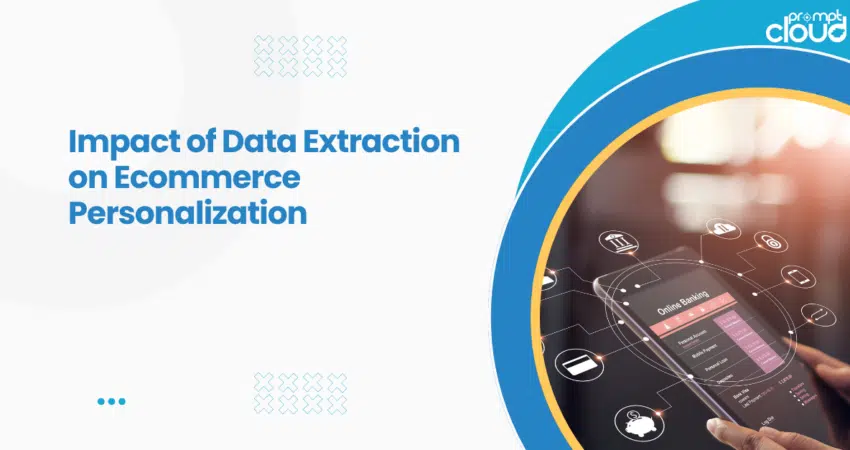
The age of personalization has transformed the ecommerce landscape, with 80% expressing a preference for personalized shopping experiences over generic alternatives. To seize these opportunities, savvy businesses rely on sophisticated ecommerce data extraction techniques, including web scraping and API integrations.
These tools grant them unparalleled access to precious data points, shedding light on customer demographics, purchasing histories, product pricing, and inventory fluctuations.
Once obtained, this wealth of knowledge undergoes rigorous refinement—cleaning, sorting, and dissecting every piece—to unlock actionable insights capable of guiding mission-critical decisions. Ecommerce retailers armed with such granular intelligence enjoy a distinct advantage: they can anticipate and respond to evolving market forces and fickle buyer appetites with speed and precision.
Consequently, their proactive approaches yield improved sales performances and deepened brand loyalties among discerning clientele. In essence, mastery of data-driven personalization represents a golden ticket to success in today’s hypercompetitive ecommerce ecosystem.
The Role of Ecommerce Data in Personalization
In shaping personalized online shopping experiences, eCommerce data is essential. By examining consumer behaviors, purchasing records, and browsing activities, retailers gain insight into customers’ individual likes and dislikes. This information enables them to recommend suitable products, customize email campaigns, and modify website designs that align with users’ preferences.
Moreover, data-backed understanding contributes greatly to constructing personalized promotions and suggestions throughout the customer experience. Effective implementation of such targeted marketing tactics has the potential to increase both customer loyalty and sales conversion rates dramatically, consequently linking data analysis directly with successful personalized marketing initiatives.
Types of Ecommerce Data
- Customer Demographics: Collecting data on age, gender, location, and income helps tailor product recommendations and marketing messages.
- Behavioral Data: Tracking website interactions, such as pages visited, items clicked, and purchase history offers insights into customer preferences.
- Transactional Data: Analyzing order values, frequency, and the time between purchases to better understand buying patterns.
- Social Media Engagement: Monitoring likes, shares, and follows can indicate customer interests and influence.
- Device Usage: Understanding whether customers use mobile devices or desktops allows for optimization of user experience.
- Customer Feedback: Gathering ratings, reviews, and survey responses provides direct input on customer satisfaction and product performance.
Techniques and Tools for Effective Data Extraction
Effective ecommerce data extraction for personalization leverages a blend of:
- Web Scraping Tools: Automating the collection of product details, pricing, and customer reviews from multiple websites.
- API Integration: Accessing structured data directly from ecommerce platforms.
- Data Mining Software: Unearthing patterns and trends for tailored recommendations.
- Machine Learning Algorithms: Predicting customer preferences based on historical data.
- Natural Language Processing (NLP): Interpreting and extracting sentiment from customer feedback.
- Optical Character Recognition (OCR): Converting images into searchable and editable data for analysis.
- ETL (Extract, Transform, Load) processes: Ensuring data is cleaned and properly formatted for use.
These tools and techniques streamline data acquisition, aiding in crafting a personalized shopping experience.
Transforming Extracted Data into Personalized Experiences
Ecommerce businesses leverage data extraction to craft personalized shopping experiences. When customers interact with online stores, their behavior—purchases, views, and search history—becomes data. Ecommerce platforms analyze this data to understand preferences and patterns.
Drawing upon the rich insights gleaned from the extracted data, businesses artfully weave together personalized product suggestions, fine-tuned email campaigns, and bespoke promotional offers tailor-made for each user.
Consider, for example, a devoted fan of Brand X who habitually peruses its virtual shelves; in recognition of their allegiance, they might just find themselves graced with exclusive deals or special savings specifically designed around their beloved label.
Additionally, website layouts can adapt to highlight items based on past interactions, making each visit unique. These practices foster loyalty and increase conversion rates, as shoppers feel seen and valued.
Examples of Ecommerce Personalization
Dynamic Product Recommendations:
A strong manifestation of ecommerce personalization lies in dynamic product suggestions. Through assessment of customers’ browsing activity, earlier acquisitions, and instant actions utilizing AI-enhanced algorithms, merchandise offerings are suggested that accurately match their inclinations and requirements. Take, for example, Amazon’s extensive utilization of this approach via presenting “Items You Might Like” or “Frequently Purchased Together” segments on product pages. Not only does this improve the overall shopping expedition, but it also raises the chance of executing supplementary transactions and product promotion.
Personalized Email Marketing Campaigns:
When considering Email Marketing Campaigns infused with personalization aspects, there exists remarkable efficacy for those operating within the ecommerce sector. Emails, fashioned in accordance with specific customer predilections, notably amplify opening probabilities and conversion percentages.
An illustration may include Sephora dispatching weekly ‘Beauty Insider’ correspondences inclusive of cosmetic guides, fresh releases, and tailored merchandise endorsements grounded on patrons’ beauty portfolios and prior procurements.
Parallel to this scenario, Starbucks personally addresses clients whilst extending pertinent benefits and reductions corresponding to their consumption tendencies within routine ‘My Rewards’ communications.
Smart Website Customizations:
Another compelling facet of ecommerce personalization involves modifying the look and feel of a site depending on known visitor characteristics. Adidas does precisely this through its interactive world map at the top right corner of its homepage.
The feature intuitively detects visitors’ locations and displays local language options along with trending sports news in that region. Additionally, once logged in, returning customers see curated collections based on their previous searches and purchases, ensuring relevancy and engagement.
Challenges and Best Practices in Data Extraction for Personalization
Extracting data for personalization in ecommerce presents several challenges.
Challenges:
- Data Diversity: Handling various data types from multiple sources can be complex.
- Data Quality: Ensuring the accuracy and cleanliness of data is critical yet difficult.
- Privacy Concerns: Balancing personalization with user privacy regulations is essential.
- Integration: Seamlessly integrating extracted data into existing systems can be a hurdle.
Best Practices:
- Advanced Tools: Utilize sophisticated data extraction tools that support diverse data formats.
- Data Cleaning: Implement stringent data cleaning processes to maintain data quality.
- Privacy Compliance: Stay updated on privacy laws and ensure compliance in data usage.
- System Compatibility: Choose extraction solutions that easily integrate with your ecommerce platform.
The Future of Personalization in Ecommerce
Personalization is evolving swiftly in ecommerce, underpinned by advanced data extraction and analysis techniques. Predictive algorithms are becoming more refined, anticipating user preferences with astonishing accuracy. Soon, shoppers will encounter:
- AI-driven product recommendations that dynamically adjust to browsing patterns
- Virtual try-ons using augmented reality, providing a tactile shopping experience online
- Enhanced customer service bots that understand and adapt to individual behaviors
- Real-time customization of websites to fit individual user preferences
The fusion of machine learning with big data ensures that personalization in ecommerce will become increasingly seamless and immersive, fundamentally transforming the shopping experience.
FAQs:
What is ecommerce data?
Ecommerce data consists of the digital traces generated by individuals throughout their internet-based shopping voyages. This data encompasses beneficial details, including demographic facts related to customers, browsing trails, transaction logs, apparatus utilization analytics, societal networking involvement, and opinions given by buyers.
Such information functions as a treasure trove for enterprises seeking advancement in their advertising attempts, improvement of consumer experiences, prediction of requirement developments, and eventually upliftment of financial flows.
Where can I find ecommerce data?
There exist two primary channels through which one could source ecommerce data – Web Scraping Techniques and Application Programming Interfaces (APIs). Web scraping entails programmatically collecting publicly available data from websites, whereas APIs provide direct access to prestructured data provided by respective platforms.
Both methodologies prove instrumental in gathering comprehensive datasets, thereby enabling deeper analyses and informed decision-making processes.
How will you track the ecommerce data?
Tracking ecommerce data typically necessitates the integration of specialized tracking software or analytical tools compatible with the underlying ecommerce platform. Common examples encompass Google Analytics, Adobe Analytics, and Mixpanel. Once installed, these tools monitor user interactions, capture key metrics, and generate detailed reports elucidating essential findings.
Moreover, employing cookies, pixels, and session recordings further fortifies comprehension regarding user navigation paths, facilitating the identification of areas requiring enhancement or modification.
What is personalization ecommerce?
Ecommerce personalization signifies tailoring online shopping experiences to suit individual user preferences and behaviors. Leveraging data-driven insights derived from collected user information, businesses aim to create customized environments whereby relevant products, services, and communication styles resonate profoundly with target audiences. Resultantly, enhanced user experiences transpire, fostering greater trust, higher conversion rates, and enduring brand loyalty.
What is ecommerce customization?
Comparatively, ecommerce customization denotes modifications made to standard features inherent to an online storefront so as to cater uniquely to particular audience sectors. Rather than focusing primarily on individual user preferences, customization efforts often revolve around attributes such as regional differences, seasonality variations, and company-specific policies. Ergo, customization caters predominantly to broader cohorts rather than singular entities, thus instigating nuanced distinctions aimed at appeasing varied subsets of customers.
Which of the following is an example of ecommerce personalization?
A prime exemplification of ecommerce personalization includes dynamic product recommendations driven by artificial intelligence algorithms. By evaluating customers’ browsing histories, earlier purchases, and concurrent conduct, AI-infused mechanisms propose commodities harmonious with their tastes and needs.
Prominent players incorporating this functionality comprise industry giants such as Amazon and Netflix, whose “Recommended for You” sections effectively magnify user engagement levels and facilitate serendipitous discoveries of potentially desirable items.
What is profiling and personalizing in ecommerce?
Profiling in ecommerce constitutes systematically amassing and scrutinizing voluminous quantities of user data to derive salient conclusions concerning their propensities, behaviors, and choices. Derived wisdom subsequently fuels meticulous segmentation procedures delineating disparate user categories based on shared traits and characteristics.
Upon establishment of these personas, personalization strategies materialize, targeting tailored content, incentives, and functionalities towards specific clusters, thereby maximizing relatability, appeal, and conversion prospects.




















